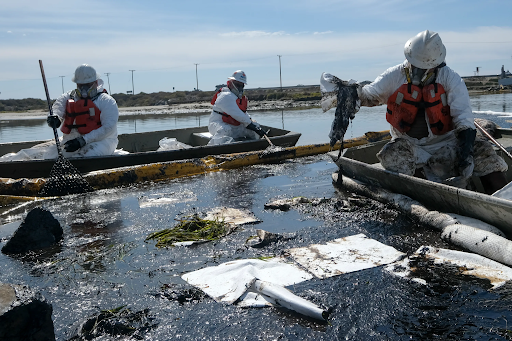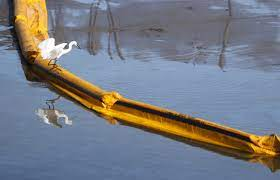California’s Catastrophic Oil Spill

Personnel cleaning up
October 18, 2021
A massive oil spill off the coast of Huntington Beach, California was first reported on the morning of Saturday, October 2, 2021. At the peak of the spill which happened at an undetermined point on Sunday, the pipeline which is thought to have caused the spill had released over 126,000 gallons of crude. This is the equivalent to 3,000 barrels of oil into the ocean.
Although the cause of the spill is not yet known, it has been confirmed that the pipeline the spill came from is operated by Beta Offshore, a subsidiary of Amplify Energy Corp. In recent years, Amplify has taken a number of fumbles, including bankruptcy four years ago, and over 125 noncompliance violations. These violations have cost the company over $85,000 in fines, and led to the injury of employees on more than one occasion.
On top of this, environmental groups have been raising alarm over faulty and aging equipment used in offshore drilling projects for years, citing that some systems that are currently in place are over 40 years old. It is known that Beta Offshore is currently working to upgrade their aging infrastructure, but it is unclear whether the leak came as a result of such projects or not.
As of October 5, only 4,000 gallons of oil have been recovered from the shore. According to officials on the scene, numerous birds and fish have already started to wash up on the shore. A few lucky birds have been found alive, but covered in oil. This comes after it was confirmed that the oil did infiltrate the ecological reserve at Talbert Marsh, home to over 90 species of birds, as well as numerous other wildlife. Mayor Avery even reported seeing dolphins swimming through the oil while inspecting the damage off the coast of his city, Newport, California (less than 10 miles from Huntington Beach). 
Once the oil is contained and the news has stopped covering the event though, ecosystems will continue to face the consequences of this accident. Among all of the birds that can no longer fly and the fish that can no longer swim, there will also be unseen consequences such as health issues from breathing in the toxic air, and maybe the most dangerous; inflation into the diets of wildlife. Eating food containing oil could negatively affect animal populations for years to come.
With this knowledge of long lasting damage to the environment, many are questioning whether federal regulatory agencies are doing enough to ensure drilling operations remain safe. Further, why was extraction of crude oil allowed so close to an ecological reserve?
These questions are the same ones that have been asked since the last large California spill in 1969; the Santa Barbara oil spill, which caused one of the first real environmental uprising after an estimated 200,000 gallons plagued the water. California is home to a population of which the majority is against off shore drilling. Because of this, the state has not leased land to any of these projects since the year 1969.
Lastly, this spill brings about the conversation of clean energy jobs, such as in solar and wind, and their increased growth and safety. After people have had to dive hundreds of feet into the ocean to find the cause of an oil spill, the conversation will inevitably turn to a transfer to cleaner, safer energy sources. Not only do these jobs usually pay higher, but they are often safer, taking into account the long term effects of working with chemicals and fossil fuels. 
As of right now, though, all eyes are focused on the cleanup of this latest catastrophe. Even after the cleanup, the Pacific ecosystems surrounding the area will suffer for decades. Some even argue that the stain isn’t ever completely wiped, given the fact that in most major spills, we are never able to recapture more than 20% of the oil we’ve released. Even more gruesome, the pipeline the oil escaped from will most likely be patched up and put to work again within the coming months.

